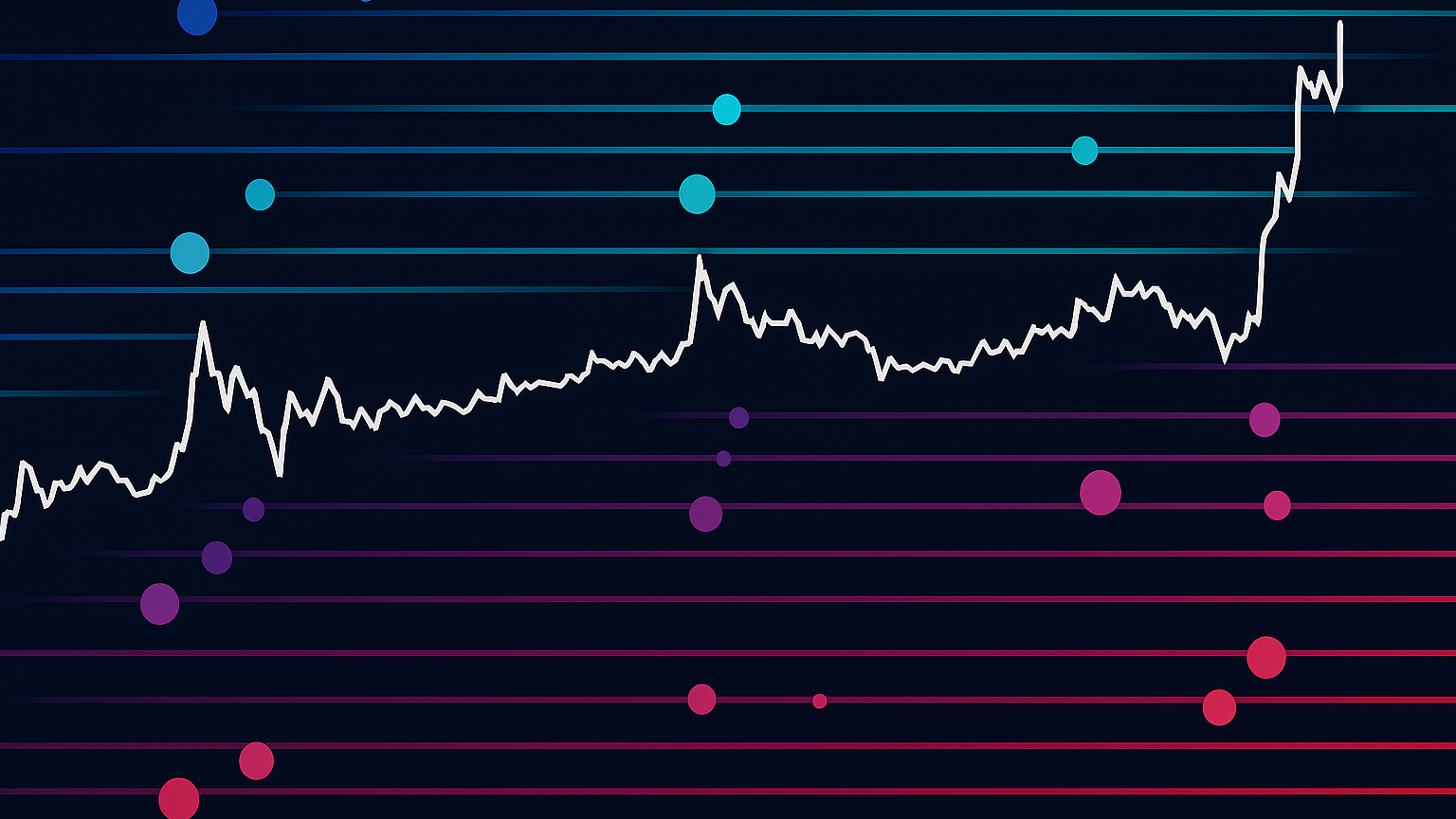Explore effective long trading strategies to capitalize on upward market trends while managing risks and maximizing profits.
Long trading is about buying assets you believe will grow in value. It works well with the historical upward trend of markets, like the S&P 500's average return of 9.80% from 1928 to 2023. Here's what you need to know:
- How It Works: Buy low, sell high. Losses are limited to your initial investment, unlike short selling.
- Why It’s Popular: Aligns with market growth, offers dividend income, and benefits from lower tax rates on long-term gains.
- Key Tools: Use moving averages, momentum indicators (like RSI and MACD), and volume analysis to spot trends and time entries.
- Risk Management: Set stop-losses, profit targets, and use trailing stops to protect gains. Keep position sizes small (1–3% of capital per trade).
Quick Comparison: Long vs. Short Trading
| Aspect | Long Position | Short Position |
|---|---|---|
| Profit Mechanism | Gains from price increases | Gains from price decreases |
| Risk Level | Limited to investment | Theoretically unlimited |
| Ownership | Direct ownership | No ownership |
| Costs | No ongoing fees | Margin interest, borrowing costs |
| Dividends | Receives dividends | Must pay dividends |
Long trading is ideal for those who want to capitalize on upward trends while managing risks effectively. Ready to start? Learn how to spot trends, time entries, and manage trades in the full guide.
Technical Analysis for Upward Trends
Moving Averages and Trend Lines
Moving averages (MAs) are a go-to method for spotting upward trends. When prices stay above an upward-sloping MA, it often signals bullish momentum. A well-known pattern, the "golden cross," happens when a shorter-term MA moves above a longer-term MA - this is often viewed as a strong bullish signal.
To identify dynamic support, draw an uptrend line connecting at least three higher lows. This highlights consistent buying pressure and a sustained upward movement.
| Moving Average Type | Characteristics | Best Use Case |
|---|---|---|
| Simple MA (SMA) | Gives equal weight to all prices | Best for long-term trends |
| Exponential MA (EMA) | Puts more focus on recent prices | Ideal for short-term trend signals |
| Multiple MAs | Uses different timeframes together | Helpful for cross-checking trends |
Momentum indicators can add further clarity to these trends.
Momentum Indicators
The Relative Strength Index (RSI) is a popular tool. When RSI drops below 30, it suggests oversold conditions, which might signal a buying opportunity in an uptrend.
The MACD indicator uses two EMAs - commonly the 26-period and 12-period EMAs - to generate signals. A bullish signal appears when the MACD line crosses above its 9-period signal line, pointing to increasing upward momentum.
But momentum indicators alone aren't enough. Volume analysis provides crucial confirmation.
Volume Analysis
Volume plays a key role in validating price movements. When prices rise alongside increasing volume, it suggests a strong and healthy uptrend. On the other hand, price increases on declining volume might indicate weakening momentum.
Richard Wyckoff famously noted:
"Prices are made by the minds of men. In drawing deductions we must play the role of detectives, seeking clues by judging the psychological reactions of all of the buyers and all of the sellers - weighing their motives through observation of the circumstances leading up to and existing at the time a change in volume occurs."
For breakout trades, volume is especially important. Strong volume during breakouts points to genuine buying interest, whereas weak volume increases the chances of a false breakout. Compare current volume to historical levels to judge the strength of the move.
Use Moving Averages Like A Pro
Long Position Entry Methods
These methods build on technical analysis to help you time your long positions effectively.
Breakouts and Pullbacks
When trading breakouts, confirm them with price action and strong volume. Only enter after the candle closes above the resistance level.
For pullbacks, focus on retracements in established uptrends. This strategy often provides a better risk-to-reward ratio compared to breakouts. The idea is to identify strong support levels where buyers are likely to re-enter.
| Entry Type | Key Characteristics | Risk Level | Best Used When |
|---|---|---|---|
| Breakout | Above resistance with volume | Higher | New trend emerging |
| Pullback | Retracement to support | Lower | Trend established |
| Breakout Retest | Return to former resistance | Moderate | After initial breakout |
Incorporating moving averages can further refine the timing of your entries.
Moving Average Signals
The Golden Cross occurs when a shorter-term moving average crosses above a longer-term one, signaling the potential start of an uptrend. For day traders, the 9- and 21-period EMAs are popular, while longer-term traders often use the 50- and 200-period SMAs.
Another signal is a price pullback to a rising moving average, followed by a rebound. This indicates strong buying pressure. Always confirm such signals with other indicators.
Momentum Entry Points
Momentum indicators are useful for timing entries within an ongoing trend:
- In uptrends, an RSI reading below 30 can indicate a strong buying opportunity.
- The MACD is another powerful tool. A bullish signal occurs when the MACD line crosses above its signal line while the price forms higher lows.
For a more precise approach, combine multiple indicators:
- Confirm the uptrend with moving averages.
- Wait for RSI to show oversold conditions.
- Look for a positive MACD crossover.
- Ensure the ADX is above 25 to confirm trend strength.
This layered approach helps filter out false signals and highlights higher-probability entry points. Remember, momentum indicators are most effective when used in line with the prevailing trend rather than trying to predict reversals.
Long Trade Management
Effective trade management is essential for protecting your profits and minimizing losses. Let's dive into key techniques that help you stay in control.
Stop-Loss and Profit Targets
Setting stop-loss levels is a must to protect your capital. Here's a striking statistic: a 95% loss requires a staggering 1900% gain just to recover. As Benjamin Graham famously said:
"Avoiding a loss takes priority over improving gains. To make up for a 95% loss in value requires the investor to make an astounding gain of 1900%."
Here are some common stop-loss methods:
| Method | Description | Best Used When |
|---|---|---|
| Percentage-Based | 1–3% for cautious traders; 5–10% for risk-takers | You're trading relatively stable assets |
| Volatility-Based | Set at 2× ATR below your entry point | Markets show consistent volatility patterns |
| Support-Based | Place stops just below a key support level | Clear technical levels are visible |
For profit targets, technical analysis can guide you. For instance, if Bitcoin is trading at $50,000 and resistance is at $52,000, setting a take-profit around $51,500 can lock in gains before a potential reversal.
Trailing Stop Methods
Trailing stops can help you secure profits while staying in the game. Choose the right strategy based on market conditions:
| Strategy | Advantages | Best For |
|---|---|---|
| ATR-Based | Adapts to changing market volatility | Dynamic market conditions |
| Moving Average | Smoothly tracks price movements | Long-term trend-following |
| Fixed Percentage | Simple to implement | Stable, trending markets |
Pro Tip: Use trailing stops only after locking in some profits. This gives your trade room to move while still safeguarding your gains.
Position Sizing
Getting position sizing right is crucial. Keep these factors in mind:
- Volatility Check: Adjust position sizes to maintain a consistent risk level.
- Risk Per Trade: Limit your risk to 1–3% of your trading capital for any single trade.
- Scaling Out: Use a Variable Trailing Take Profit (TTP) strategy. This lets you exit portions of your position at different price levels, locking in profits while staying open to further gains.
Next, we'll dive into tools that can sharpen your technical and fundamental analysis.
Advanced Trading Tools
Multi-timeframe analysis helps traders combine various timeframes to reduce false signals and spot profitable opportunities.
| Timeframe Level | Purpose | Key Benefits |
|---|---|---|
| Higher (Weekly/Daily) | Establish the main trend | Reduces market noise |
| Intermediate (4H/1H) | Generate trade signals | Confirms the trend's direction |
| Lower (15m/5m) | Refine entries and exits | Improves trade timing |
For instance, in November 2023, Bath & Body Works (BBWI) showed a bullish weekly signal with a 12-week SMA crossover. This was confirmed on the daily chart, leading to a breakout above resistance. Using the 4-hour chart for entries, traders captured a 27% rally.
Technical and Fundamental Mix
Combining technical and fundamental analysis can give traders an edge. A study from March 2023 found that this approach performed better than simple buy-and-hold strategies.
"Investing is risky. The more confluence one could find pointing toward a similar direction, the better."
Here’s how to apply this method:
- Start with fundamental analysis to pick strong assets and gauge market direction.
- Use technical analysis to find precise entry points.
- Confirm price movements with volume trends.
- Track short-term moving averages to fine-tune timing.
LuxAlgo Trading Tools
LuxAlgo simplifies advanced trading techniques for over 15,000 traders.
| Feature | Application | Trading Benefit |
|---|---|---|
| Price Action Concepts | Automated pattern detection | Highlights high-probability setups |
| Signals & Overlays | Real-time trend tracking | Validates entry and exit points |
| AI Backtesting Assistant | Strategy testing | Helps improve success rates |
"Lux Algo has really stepped my trading up, it offers setups for every trading style, freeing you from restrictive approaches."
LuxAlgo offers three subscription options . The Ultimate plan ($59.99/month) includes AI backtesting and priority support, while the Premium plan ($39.99/month) provides essential trading tools and screeners but lacks AI features.
Conclusion
Key Points Review
Long trading success relies on thorough technical analysis and disciplined risk management. A clear trading plan keeps decisions consistent and avoids impulsive actions.
| Component | Purpose | Implementation |
|---|---|---|
| Trading Plan | Provides structure | Set entry/exit rules and risk boundaries |
| Technical Analysis | Identifies trends | Use tools like moving averages and momentum indicators |
| Risk Management | Protects capital | Use stop-loss orders and trailing stops |
With these core elements in place, you can begin executing your strategy effectively.
Implementation Steps
- Document Your Trading Plan
"A trading plan is a document we create for ourselves that outlines exactly how we will trade and operate in relation to our trading activities. Having a trading plan, and following it, builds consistency and allows for improvement over time. Trading based on whim or ever-changing strategies and ideas doesn't."
- Build a Strong Technical Analysis Foundation
Use trend and momentum analysis to spot upward trends. Confirm trends with price action and volume data.
- Set Risk Parameters
- Decide the maximum position size.
- Place stop-loss orders below key support levels.
- Set profit targets at technical resistance points.
- Define the maximum loss you’re willing to accept.
- Test and Refine Your Strategy
Evaluate and improve your approach by:
- Reviewing historical charts.
- Practicing with a demo account.
- Analyzing performance metrics.
- Making necessary adjustments to optimize results.
"Trend analysis tries to predict a trend, such as a bull market run, and ride that trend until data suggests a trend reversal, such as a bull-to-bear market."






